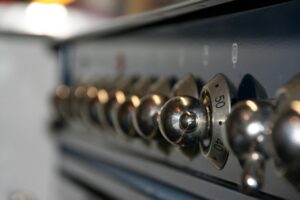Troubleshooting appliances is the process of identifying and resolving issues that may arise with household appliances. It involves diagnosing the problem, identifying the source of the issue, and implementing the necessary repairs or replacements. Troubleshooting appliances is an essential skill for homeowners as it can save time and money by avoiding costly repairs or replacements. It also allows individuals to maintain their appliances in good working condition, ensuring their longevity and efficiency.
Key Takeaways
- Troubleshooting appliances can save money and time, but it also comes with risks.
- Understanding the risks associated with troubleshooting appliances is crucial for safety.
- Safety gear such as gloves, goggles, and insulated tools are necessary for troubleshooting appliances.
- Preparing the appliance for troubleshooting involves unplugging it and removing any covers or panels.
- Identifying the source of the problem and turning off the appliance safely are important steps in troubleshooting appliances.
Understanding the Risks Associated with Troubleshooting Appliances
While troubleshooting appliances can be a cost-effective solution, it is important to be aware of the risks involved. One of the main risks is electrical hazards. Appliances are powered by electricity, and mishandling them can lead to electric shocks or even electrocution. It is crucial to take proper precautions and ensure that the power source is disconnected before attempting any troubleshooting.
Another risk associated with troubleshooting appliances is fire hazards. Faulty wiring or damaged components can cause electrical sparks, leading to fires. It is important to be cautious when working with appliances that have been damaged or have a history of electrical issues.
Chemical hazards are also a concern when troubleshooting appliances. Some appliances, such as refrigerators or air conditioners, contain refrigerants that can be harmful if released into the environment. It is important to handle these substances with care and follow proper disposal procedures.
Lastly, physical hazards should not be overlooked when troubleshooting appliances. Moving parts, sharp edges, or heavy components can pose a risk of injury if not handled properly. It is important to use caution and wear appropriate safety gear to protect oneself from these hazards.
Safety Gear Needed for Troubleshooting Appliances
To ensure personal safety while troubleshooting appliances, it is essential to have the right safety gear. Protective clothing such as long-sleeved shirts and pants can help protect against cuts, burns, or chemical spills. Safety glasses are crucial for protecting the eyes from debris or chemicals. Gloves should be worn to protect the hands from sharp edges, electrical shocks, or chemical exposure. In some cases, a respirator may be necessary to protect against harmful fumes or dust particles.
Preparing the Appliance for Troubleshooting
Before starting any troubleshooting process, it is important to prepare the appliance properly. The first step is to unplug the appliance from the power source. This ensures that there is no risk of electric shock while working on the appliance. Next, any covers or panels that may be obstructing access to the internal components should be removed. This allows for a thorough inspection and easier identification of the problem. Finally, it is important to visually inspect the appliance for any visible damage such as frayed wires, burnt components, or leaks.
Identifying the Source of the Problem
Once the appliance is prepared for troubleshooting, the next step is to identify the source of the problem. This can be done by using a multimeter to test for electrical current. By testing different components and connections, it is possible to determine if there is a break in the circuit or if a specific part is faulty. Loose connections should also be checked as they can cause intermittent issues or complete failure of the appliance. Additionally, inspecting parts for damage or wear can help identify components that need to be replaced.
Turning off the Appliance Safely
After identifying the source of the problem and before attempting any repairs or replacements, it is crucial to turn off the appliance safely. This involves unplugging it from the power source and shutting off the circuit breaker that supplies electricity to the appliance. In some cases, it may be necessary to lock out the power source to prevent accidental reconnection while working on the appliance. This ensures that there is no risk of electric shock during the troubleshooting process.
Testing the Appliance for Electrical Current
Once the appliance is safely turned off, it is important to test it for electrical current to ensure that there is no residual power. This can be done using a multimeter to test for voltage. By checking for continuity, it is possible to determine if there is a complete circuit or if there is a break in the electrical flow. Testing switches and fuses can also help identify any faulty components that may need to be replaced.
Replacing Faulty Parts Safely
If the troubleshooting process reveals that a specific part is faulty and needs to be replaced, it is important to do so safely. This involves ordering the correct replacement parts from a reputable supplier. It is crucial to follow the manufacturer’s instructions for installation to ensure proper functioning of the appliance. After replacing the faulty part, it is important to test the appliance to ensure that the issue has been resolved.
Cleaning and Maintaining the Appliance After Troubleshooting
Once the troubleshooting process is complete and the appliance is in working order, it is important to clean and maintain it properly. Wiping down surfaces with a damp cloth can help remove any dirt or debris that may have accumulated during the troubleshooting process. Lubricating moving parts can help reduce friction and extend their lifespan. Additionally, checking for wear and tear on components can help identify any potential issues before they become major problems.
When to Seek Professional Help for Troubleshooting Appliances
While troubleshooting appliances can be a cost-effective solution, there are instances when it is best to seek professional help. If the problem is beyond your expertise or requires specialized knowledge or tools, it is advisable to consult a professional technician. Additionally, if the appliance is still under warranty, attempting repairs yourself may void the warranty. Lastly, if the risk of injury is too high or if there are concerns about personal safety, it is best to leave the troubleshooting to professionals who have the necessary training and experience.
Troubleshooting appliances is an important skill for homeowners to have. It allows individuals to identify and resolve issues with their appliances, saving time and money. However, it is crucial to prioritize safety when troubleshooting appliances. Understanding the risks associated with troubleshooting, using the appropriate safety gear, and following proper procedures can help prevent accidents and injuries. It is also important to know when to seek professional help, especially when the problem is beyond your expertise or when personal safety is at risk. By prioritizing safety and seeking professional help when necessary, individuals can ensure the longevity and efficiency of their appliances.
What Safety Precautions Should I Take When Troubleshooting Appliances?
When troubleshooting appliances, it’s important to prioritize safety precautions for appliances. Always unplug the device before attempting any repairs. Use insulated tools to avoid electrical shock. Wear protective gear like gloves and goggles to prevent accidents. If in doubt, consult a professional to ensure safety.
FAQs
What are safety precautions when troubleshooting appliances?
When troubleshooting appliances, it is important to take safety precautions to avoid accidents and injuries. Some of the safety precautions include turning off the power supply, wearing protective gear, and using the right tools.
Why is it important to turn off the power supply?
Turning off the power supply is important to avoid electric shock. Appliances are connected to electricity, and if the power supply is not turned off, there is a risk of electrocution.
What protective gear should be worn when troubleshooting appliances?
Protective gear such as gloves, goggles, and aprons should be worn when troubleshooting appliances. Gloves protect the hands from sharp edges and hot surfaces, goggles protect the eyes from debris and chemicals, and aprons protect the body from spills and stains.
Why is it important to use the right tools?
Using the right tools is important to avoid damaging the appliance and to ensure that the troubleshooting process is done correctly. Using the wrong tools can cause damage to the appliance and can also cause injury to the person troubleshooting the appliance.
What are some other safety precautions to take when troubleshooting appliances?
Other safety precautions to take when troubleshooting appliances include working in a well-ventilated area, keeping the work area clean and organized, and following the manufacturer’s instructions and safety guidelines.



